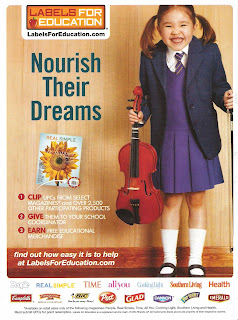 For some time now the two big prominent label collection efforts, General Mills Boxtops for Education and the much more senior and yet smaller Label’s for Education... founded by Campbell’s... have opened their respective campaigns to non-competing brands. It’s the classic win-win.
For some time now the two big prominent label collection efforts, General Mills Boxtops for Education and the much more senior and yet smaller Label’s for Education... founded by Campbell’s... have opened their respective campaigns to non-competing brands. It’s the classic win-win.In so doing, they broaden their exposure and increase the amount of possible funds raised for schools. I suspect Campbell’s and General Mills also broaden their cost structure.
Meanwhile, the new partners are happy to participate with either of these well-established efforts because all the groundwork has long since been laid down and because both efforts enjoy strong relationships with tens of thousands of schools nationwide.
To get to this point both of the original sponsors have made efforts to erase their names from the efforts. ‘Boxtops’ is no longer named for General Mills. Label’s no longer features Campbell’s name or branding.
With all that now behind them one of label campaigns has the opportunity to take it to the next step by stripping out the increasingly anachronistic nouns in their names; ‘boxtops’ and ‘labels.’
Boxtops for Education participants now include such non-boxed items as Green Giant broccoli, Boise printer paper, and Hefty paper plates and platters. The ad at the left announces that seven Time, Inc. magazines titles have now joined Labels for Education campaign. Clip the UPCs from the magazines and take them to the schools; just the same as clipping the Label’s for Education seals off containers of Emerald nuts or Glad storage bags.
Plenty of brands have made this kind of transition. When it was becoming a computer company way back in the 1940s and 1950s, International Business Machines was hampered by its name, so it became IBM. Kentucky Fried Chicken wanted to get away from all three of its names, so it became KFC.
Making your name an acronym is the easiest way to rebrand. BFE and LOE don’t exactly sing. But neither did AT&T the first time anyone heard it.
‘Boxtops’ or ‘Labels’ could go all the way and completely rename their efforts. I won’t suggest any names, but it would be fun to help them rename their campaigns.
Why would they bother?
Think back on the IBM and AT&T examples. How does IBM sell business services if its name still says ‘Machines’? How does AT&T sell wireless telephony if its name still says ‘Telegraph’?
To be more pointed, how does Boxtops expand its effort to companies that don't have boxes?
The counter argument is that Labels for Education and Boxtops for Education have decades of built-in brand equity. There’s no denying that.
But more valuable still is all the infrastructure both efforts have in their relationships with tens of thousands of schools nationwide. Leaving aside Scholastic, what other brand can you name that is literally in every school in the country and for whom schools and parents both have largely positive feelings?
Given that, Boxtops and Labels could both be much bigger if they were willing to jettison their legacy names.
Comments